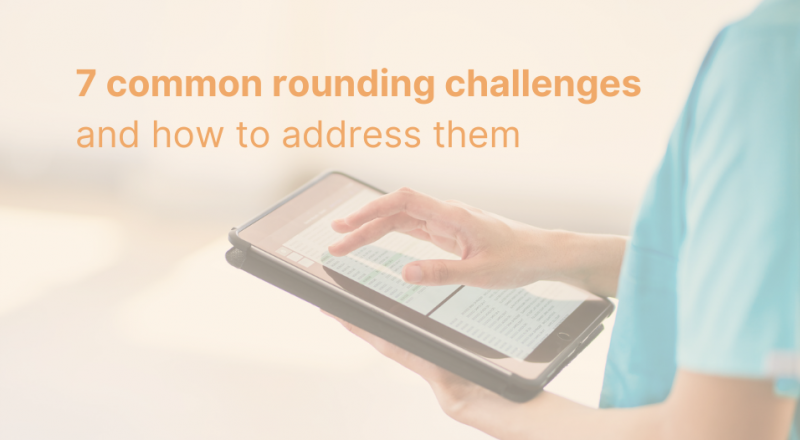By Joy Avery, MSN, RN and Donna Pritchard, DNP, MSN, FNP-BC
New technologies, from EHRs to telehealth to patient engagement tools, have had profound effects on patient care. Generally speaking, they have created essential links between providers and patients during the pandemic, widened access to healthcare, and improved patient data collection and staff resource allocation. However, as more digital tools are introduced, they can also be a hindrance to building empathy in healthcare and meaningful relationships between patients and providers.
When a nurse pulls a rolling EHR workstation into a room, puts their back to a patient and begins inputting information, an opportunity for connection and patient satisfaction is lost. If a patient is speaking and a clinician averts their eyes away to a digital tablet too many times, that patient may no longer feel listened to; trust is diminished. When a recently discharged patient is experiencing worsening symptoms at home, engaging with pre-recorded, automated questions is only a means to end—they want to speak to a nurse as soon as possible.
Complicating matters, the COVID-19 pandemic has led to severe burnout and compassion fatigue amongst healthcare professionals, leading to high turnover. Under these high-stress circumstances, it can be difficult to offer empathy and reassurance.
Decreasing expressions of empathy are cause for concern. The importance of empathy in the clinical setting has been well documented—it increases both patient satisfaction and patient compliance and enhances a practitioner’s ability to treat patients. Moreover, empathy has strong positive effects on patients’ health outcomes.
The bottom line: an empathetic interaction fulfills the patient’s need to be seen and understood. It is critical to establishing a successful provider-patient relationship. And both physicians and nurses alike are more effective healers—and enjoy more professional satisfaction—when they work to be empathetic towards their patients. As healthcare becomes increasingly digital, how do we preserve empathy for both patients and healthcare practitioners?
Make patient rounding purposeful, along with digital tools
Digital rounding tools have a myriad of benefits, including improvements to clinical workflows and patient outcomes. But new technologies have a way of commanding the user’s attention, taking their focus away from the patient experience. This is especially true if they are new users and are accustomed to using manual, paper and pen processes.
In order to make rounding purposeful, clinicians and nurses need to make time for heartfelt, relaxed and unhurried interactions with patients that do not follow a tight script. Asking permission to sit down next to the patient and pulling the chair close to the bedside can have a positive effect—studies show that patients perceive a provider has spent more time with them when they sit rather than stand.
Even if health professionals are wearing masks, patients can still read faces and body posture—whether or not a nurse is making eye contact, smiling, actively listening and demonstrating genuine care. All these expressions of empathy go a long way towards comforting a frightened patient.
Providing a gentle touch, if appropriate, is extremely valuable to patients in need of reassurance. This gets lost if clinicians and nurses are at a distance from the patient or have their back turned to a screen. Human touch can reduce cortisol levels caused by stress hormones; compassion can reduce pain after surgery, improve survival rates and boost the immune system. Patients are more likely to trust healthcare staff and gain comfort from these interactions, lessening any feelings of panic and loss of control.
As importantly, taking a moment to show patients your digital tools and explaining how and why you as a healthcare professional are using it—to look at their previous history, to notify other members of the care team about their needs, to share a dietary or food preference—demonstrates to the patient that you are working to ensure that nothing gets missed.
Offer timely, compassionate support post-discharge
Automated, post-discharge outreach is a critical part of improving patient outcomes. The technology allows providers to get patients the time-sensitive information and resources they need and requires fewer staff members to be effective. But automated communications can come at the cost of human outreach and clinical empathy. One way to address this is to educate patients about the calls they will receive ahead of time, prior to discharge, and make sure they know a nurse will be available to talk to them if needed.
If a patient reports an issue, the call back from a nurse is an opportunity to develop a relationship with that patient. A kind, warm voice enhances the quality of that care. Attentive listening and empathic curiosity about this person on the other side of the call can bolster communication and foster trust.
Moreover, patients who report an issue are owed a call back within 2 hours. An urgent response by a nurse or another healthcare worker demonstrates to patients their issues are a priority, that someone is concerned for their well-being and they will not be overlooked. Research shows that patients that were called back by a nurse in less than 2 hours had 20% less readmissions than patients called back in more than that timeframe.
Find redundancies that are reducing time spent connecting with patients
Nurses spend a great deal of time documenting in patients’ medical charts. Often, there are redundancies when the same information is charted in multiple systems. This adds time to healthcare staff’s workload, fixes their attention on digital tools and reduces the time they can spend connecting with patients and their families.
At North Mississippi Medical Center (NMMC), a recent review showed that nurses were spending an average of 86 minutes documenting for each patient. And anytime a patient was admitted or discharged from a unit, it added 40 more minutes of documentation time.
Additionally, the COVID-19 crisis led to higher numbers of patients, sicker patients, staffing shortages and increased stress amongst remaining staff. All of this exacerbated the problem and negatively impacted nurses ability to provide empathetic and compassionate care.
At NMMC, they found a solution: removing duplicate data issues and reducing the frequency the nurses were required to document certain items (while remaining compliant with regulatory standards) lessened the workload and created more time for nurses to focus on patients.
Using technology to improve empathy in healthcare
Ultimately, technology is needed for progress in medicine, but there is no replacement for human relationships. Rather than letting new technologies come between patients and healthcare providers, the challenge is to find ways to use and showcase them for what they are—tools to enhance patient care and experience.
Preserving empathy means not only forging a connection, but involving patients, as much as possible, in the workflow related to their care. Verbalize to them how and why you are using digital tools to support them; show them the steps and prompts appearing on your screen; ask if they have any questions about the process.
At the end of the day, patient perceptions of their care are not only related to the clinical—their diagnosis, their treatment. They are very much informed by the quality of the interactions they have with their nurses, clinicians, and every healthcare provider they come in contact with. They will remember the attention, kindness and respect they received.








